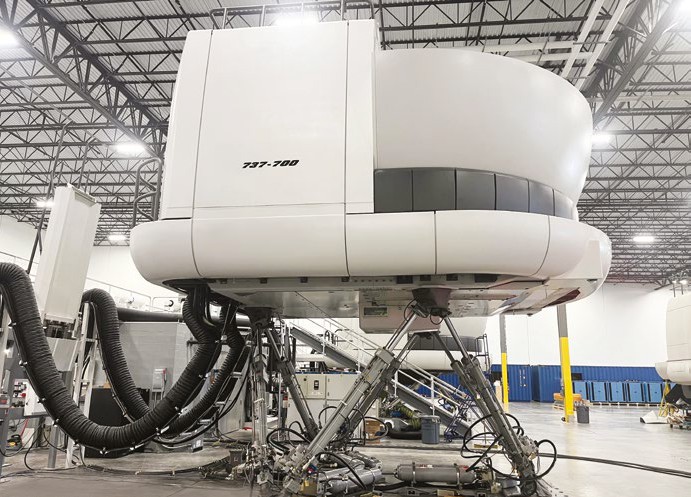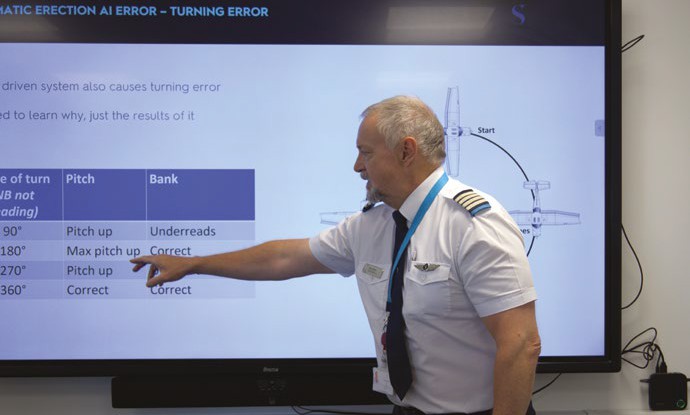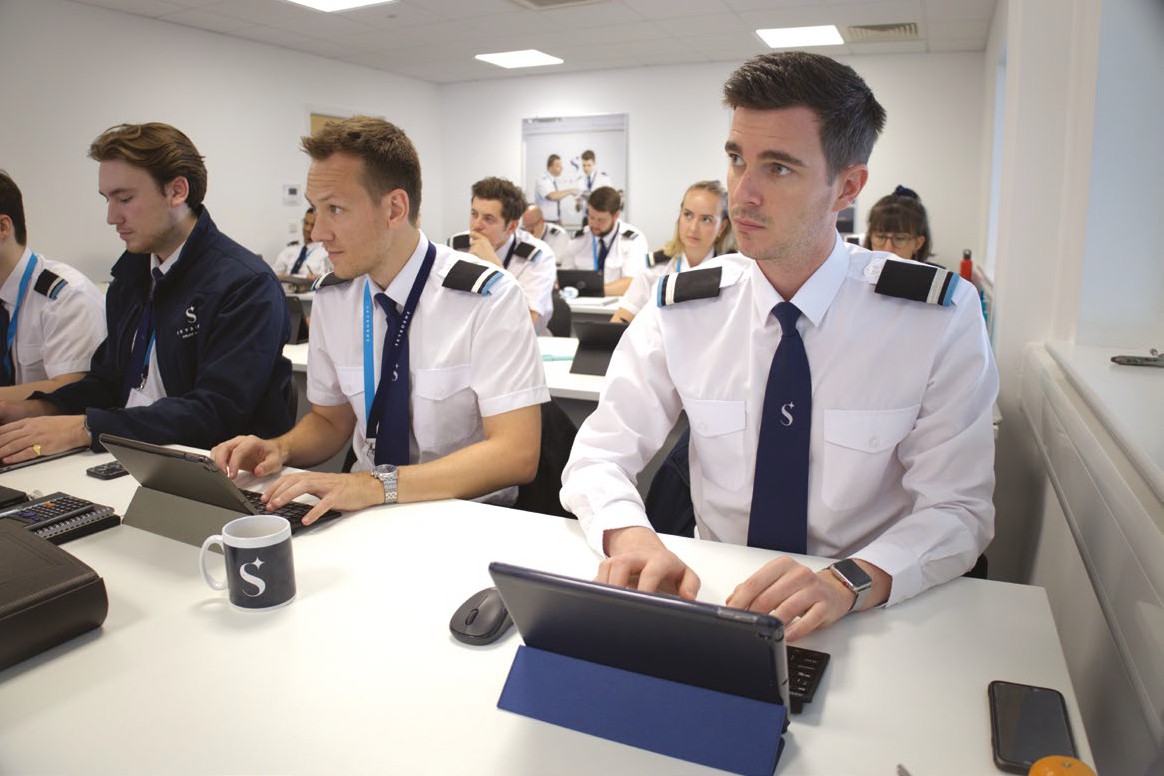The global pilot shortage has intensified pressure on the industry to train pilots quickly while maintaining high standards. Keith Mwanalushi finds out how training providers are rising to the challenge.
Multi-crew Pilot License (MPL) training.
This covers theory, flight training on single- and multi-engine aircraft, and aircraft type- specific full flight simulator training.
The aim is to fully prepare cadets to long-term demand for newly qualified aviation professionals remains strong. Boeing, for example, forecasts that
674,000 new pilots will be needed between 2024 and 2043 to fly the global commercial fleet.
To achieve ambitious growth goals, most airlines like low fare and regional airlines need a steady stream of flight crew, but they can face criticism for relying on fast-tracked training programmes.
In reality, a mix of traditional classroom instruction and digital platforms are used to provide flexibility in pilot training.
According to Kenneth Mark Sorensen, Head of Training at BAA Training, digital technology is revolutionising flight training by making theoretical instruction more interactive and engaging.
He says: “This innovative approach not only involves traditional instructional techniques but also incorporates advanced online e-learning platforms that allow students to engage with the material at their own pace.”
He notes that virtual reality training offers immersive experiences that simulate real- flight scenarios, thereby providing trainees with a comprehensive understanding of complex concepts and procedures.
“This combination of interactive and digital tools enhances the overall learning experience, making it more effective and accessible for aspiring pilots,” he says.
THEORY AND PRACTICE
In October 2024, BAA Training signed a contract with Spain’s Volotea airline to provide cadet pilot training, with the first cadet batch starting in February 2025.
The cadet programme will provide airline- specific, full-scope, competency-focused operate within Volotea-specific procedures and, importantly, the cadet programme offers job security to pilots under training.
Elsewhere, Laura Macutkevic, Vice President People and Culture at ACMI operator Avion Express, recently acknowledged the importance of developing effective training programmes for pilots and fostering strong partnerships with training academies to smooth the transition for cadets into active flying roles.
Avion Express released 50 cadets as first officers in 2024 and Macutkevic emphasises the vital role that airlines play in the career paths of new pilots.
“The journey to becoming a professional pilot is rigorous, and airlines have a responsibility to invest time and resources to make this pathway more efficient and accessible,” she says, adding that partnerships with pilot training academies were as important as internal efforts.
“Our collaboration with BAA Training, for instance, allows us to streamline the training process and deliver results that benefit both pilots and airlines. We are proud to see so many new pilots turning into first officers and joining Avion Express this year [2024].”
Avion Express claims it was the first ACMI operator in 2024 to have a simulator exclusively dedicated to its needs, in partnership with BAA Training, and its pilot training momentum is expected to increase in 2025.

Boeing forecasts that 674,000 new pilots will be needed between 2024 and 2043 to fly the global commercial fleet.
HYBRID APPROACH
Meanwhile, Skyborne Academy in the UK has adopted a hybrid approach to theoretical knowledge training for its UK CAA Airline Transport Pilot Licence (ATPL), combining tutor-led instruction with self- directed Computer-Based Training (CBT).
Lee Woodward, the Chief Executive at Skyborne, believes this approach allows trainees to benefit from structured learning while also providing the flexibility to study independently and augment their knowledge using iPads preloaded with the entire syllabus.
“This blend of traditional and digital methods addresses different learning styles and offers trainees the ability to revisit materials as needed,” he says.

Skyborne is yet to incorporate virtual reality (VR) or augmented reality (AR) into flight training, but Woodward sees great potential in their application.
“I am certain there is a place for VR and AR in the near future,” he says. “Skyborne is actively in discussion with several OEMs to evaluate the integration of these technologies.”
Global training organisation, CAE, has been leading the charge for integrating new technologies into training solutions.
A good example is the CAE immersive pilot training app using the Apple Vision Pro headset.
“The CAE app uses spatial computing to bring true-to-life precision to flight deck interactions and will allow pilots to remotely complete training activities that are currently only available in training centres,” says Michel Azar-Hmouda, CAE Division President for Commercial Aviation.
He explains that as part of CAE’s training ecosystem, the app will enable pilots to train any time from anywhere. All they’ll need is Apple Vision Pro uploaded with the CAE app.
“The CAE app will allow pilots to familiarise themselves with the flight deck, practise critical procedures, and develop muscle memory for key functions from anywhere, whether home or a hotel room,” Azar-Hmouda says.
In other simulator-related news, Pan Am Flight Academy has announced the acquisition of its newest Level D Boeing 737- NG full-flight simulator, which is now installed at the new Pan Am Flight Academy training centre in the Axis Park complex in Hialeah, Florida.
The simulator is equipped with 737-NG standard specifications, featuring CFM-56 engine platforms and integrated with visuals from Rockwell Collins/EP8000 and HUD (Heads-Up Display), allowing for autoland and rollout capabilities.
The training offering on this simulator started in November 2024.
MONITORING PERFORMANCE
Training programmes increasingly use flight data analysis to identify weaknesses in pilot performance, leading to real-time feedback being integrated into industry training sessions.
Skyborne recently introduced flight data monitoring (FDM) across its piston-engine fleet. “While we primarily use FDM for monitoring overall activity, we also use the data to inform our safety management processes,” says Lee Woodward.
The goal at Skyborne is to develop evidence-based training protocols as the airline partners do, ensuring that potential issues can be identified early and addressed proactively, leading to improved safety and efficiency throughout the training process.
BAA Training has been including such data in its training for some time now, according to Sorensen.
He says: “It incorporates more clearly defined performance indicators we know as the nine core competencies, which effectively outline the essential qualities a pilot must possess to successfully complete a training session.”
As Sorensen explains, these performance indicators, in conjunction with a digital platform that collects and displays the grades of both students and instructors, provide training organisations with a comprehensive overview of the current quality of training.
“That, in turn, allows us to make adjustments if and where necessary to ensure that high quality throughout,” he says.

In terms of real-time feedback in pilot performance, CAE utilises a solution called CAE Rise – a data-driven training system that leverages big data analytics to make training more objective, efficient and effective.
The system gives instructors the ability to deliver standardised training and objectively assess pilot competencies using live data during training sessions.
“It is an example of how CAE is leveraging advanced data analytics and integrated technology toolsets to improve pilot training,” says Azar-Hmouda.
CAE Rise uses metrics-based insights (MBI) and telemetry data to show pilot instructors objective data during simulator training sessions, allowing them to focus on evaluating the trainee’s soft skills.
The technology, which CAE has developed for both civilian and military pilot training, also provides analytics to proactively detect, and ultimately address, emerging safety concerns.
According to Azar-Hmouda, the technology uses analytics to identify trends and optimise training programmes, also ensuring that students have correctly grasped the information.
CAE believes this enhances the quality and efficiency of training and ensures pilots are better prepared.
Azar-Hmouda says the CAE Rise upcoming releases integrate biometrics like gaze and pulse with telemetric data to further augment insights.
Currently in use, he says CAE Rise is already benefiting pilots by offering enhanced training and real-time feedback.
SMARTER LEARNING TOOLS
In November 2024, digital aviation publisher Padpilot unveiled its new digital eLearning suite for ATPL (Airline Transport Pilot Licence) theory, an update to computer- based training.
Nathan Gray, Chief Executive at Padpilot, explains that integrating the company’s theoretical knowledge resources into a pilot training school’s programme begins with a demo or trial.
“This may include our interactive eBooks, instructor presentations, learning management systems, new e-learning courses and the AI-powered Padpilot Briefing Room,” he says.
Additionally, schools licence their bespoke package of resources, and Padpilot provides full support with implementation, training and ongoing assistance to ensure a smooth transition and successful training delivery.
Gray believes the pilot training industry is increasingly embracing artificial intelligence.
“We’re seeing airlines and approved training organisations (ATOs) adopting AI-powered simulators and learning
platforms to personalise training, accelerate learning and improve pilot performance.”
REGULATOR PERSPECTIVES
As the demand for air travel returns robustly in the wake of the pandemic, regulators must ensure that safety standards are not compromised in the rush to certify new pilots.
Barry Mooney, Flight Operations Manager for Training at the UK’s Civil Aviation Authority (CAA), refutes claims of any cutting of corners.
“There are no condensed or accelerated programmes,” he says. “Syllabus content and standards are fixed and set out in regulation to maintain consistency and safety.”
The CAA maintains these high standards for safety and competency in different ways, including regular audits and inspections, continuous monitoring, and pilot licence standards.
Similarly, the US Federal Aviation Administration (FAA) closely monitors airline safety, including training programmes, through numerous channels such as the FAA’s continued operational safety process and the use of a commercial aviation safety team.
In addition there are a number of voluntary reporting programmes that enable aviation professionals, including pilots, to report any safety concerns anonymously.
The FAA also requires US airlines to have safety management systems – a set of policies and processes that enable airlines to identify potential hazards in their operations, assess the risks from those hazards, implement measures to address those risks, and ensure those measures are effective.
Competency-Based Training and Assessment (CBTA) is a shift from traditional hour-based training, but reportedly its implementation varies widely across organisations – perhaps sparking some concerns about consistency in adoption, standardisation and monitoring of competency assessments globally by regulators.
Mooney disagrees with that notion, saying: “Whilst there are still regulatory minimum hours for various licensing qualifications, CBTA provides a framework that embeds competencies throughout a pilot’s career and builds resilience into the system.”
He explains that CBTA focuses on developing and evaluating individuals based on their demonstrated competencies or skills, rather than adhering to rigid training requirements.
Furthermore, CBTA scenario-based training programmes are currently more applicable to operators’ training programmes, whereas ATOs conducting licensing training would apply CBTA principles to their training while following the prescribed syllabus set out in the regulations.

MANAGING AUTOMATION
The arrival of next-generation aircraft types coupled with new training techniques means pilots are becoming increasingly reliant on automation, supposedly leading to skill degradation in manual flying and decision-making.
At the same time, suggestions of requirements for minimum hours of manual flight per year are vague.
Mooney notes that automation in modern aircraft is intended to enhance safety and reduce pilot workload, but it is crucial that pilots remain capable of manual control when necessary.
He says: “While there are no specific requirements for minimum manual flight hours per year, the CAA ensures through the oversight of operator training programmes
hat pilots maintain their manual flying skills and decision-making abilities through rigorous and regular simulator training.”
Mooney points out that these training sessions cover normal, abnormal, and emergency procedures, ensuring that pilots are well prepared to handle a variety of situations manually.
“Also, regular simulator training is designed to keep pilots proficient in manual flying and adept at making critical decisions. By practising in a controlled environment, pilots can refine their skills and stay sharp, even if they do not frequently fly manually in real-world operations.”
The CAA mandates comprehensive training that includes significant manual flying components, even though modern aircraft are designed to be primarily flown using automation.
The FAA recently issued new guidance and recommended practices for flight path management when operating aircraft with highly automated systems.
Even in autopilot mode, the flight crew should always be aware of the aircraft’s flight path and be able to intervene if necessary.
